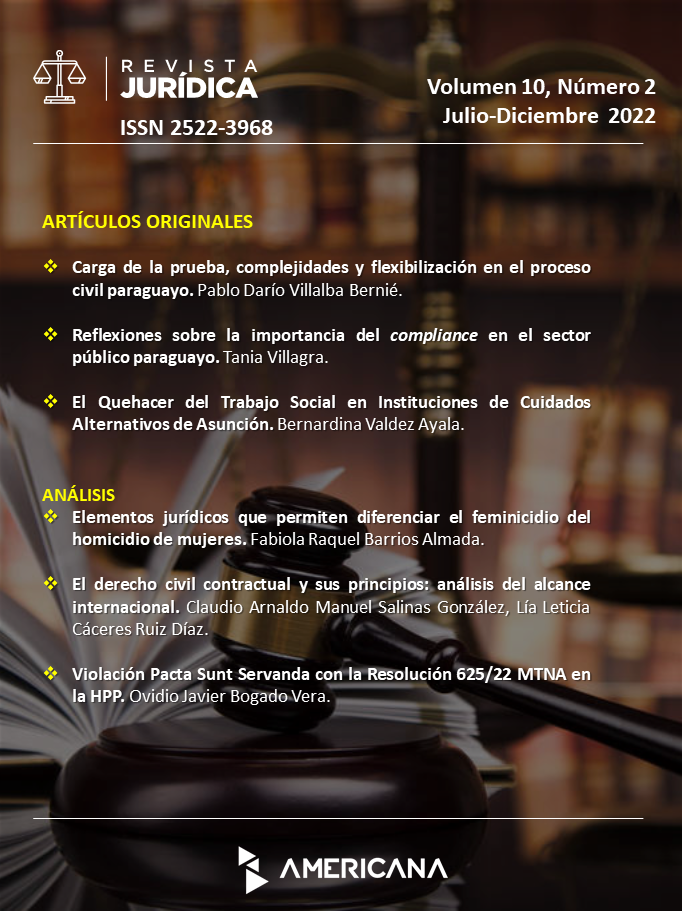Legal elements that allow differentiating femicide from the homicide of women
DOI:
https://doi.org/10.30545/juridica.2022.jul-dic.4%20Keywords:
Femicide, cycle of violence , criminal type of homicide, criminal type of femicideAbstract
This work aims to clarify in detail the correct classification of feminicide, given the high increase in feminicides nationwide. Thus, the main objective of this study is to correctly identify the elements that constitute the criminal type of feminicide and allow us to distinguish it from the homicide of women. The methodology used is qualitative because information set out in the law itself was collected, and all the knowledge on the topic developed was built based on that information obtained, starting from an inductive method, that is, in accordance with the elements that constitute the objective type. and the subjective type that were discovered as established by the law itself. However, it was verified that although the same criminal legislation establishes or delimits the constitutive elements of the criminal type of feminicide, it is ultimately the Supreme Court of Justice that takes a position regarding the analysis of cases judged as feminicide.
Downloads
References
Anaya de Pauta, B. S. (2012). El feminicidio: un atentado contra la dignidad de la mujer. IUS Revista de investigación de la facultad de derecho, 12-15.
Bardales O., V. H., & Vázquez. (2012). Feminicidio bajo la lupa. Lima: Biblioteca Nacional del Perú.
Bolaños González, M. (2007). El objeto material de la acción delictiva. Aspectos jurídicos y filosóficos. Repositorio Institucional de la Universidad de los Andes.
Castillo Aparicio, J. E. (2014). El delito de Feminicidio. Análisis doctrinal y comentarios a la Ley N° 30068. Normas Jurídicas S.A.C.
Constitución de la República del Paraguay. (20 de junio de 1992). Asunción, Paraguay.
Cruz, M. (2017). Un abordaje de la noción de feminicidio desde una perspectiva psicoanalítica como recurso para mejorar la aplicación de la normativa legal vigente. Ajayu Órgano de difusión científica del Departamento de Psicología UCBSP, 217.
Cuervo, M. (2013). Descripción y caracterización del Ciclo de Violencia que surge en la relación de pareja. Revista de Tesis Psicológica, 8 (1), 80-88.
Facio Montejo, A. (1992). Cuando el género suena cambios trae. San José, Costa Rica: Ilanud.
González y otras vs. México (Excepciones preliminares), Sentencia de fecha 16 de noviembre (Corte Interamericana de Derechos Humanos (CIDH) 16 de Noviembre de 2009).
Ley 5378/2014 que modifica el Art. 229 del Código Penal Paraguayo. (28 de agosto de 2014). Asunción, Paraguay.
Ley 605/95. (8 de junio de 1995). Asunción, Paraguay.
Ley de Protección Integral a la mujer contra la violencia. (06 de noviembre de 2016). Asunción, Paraguay.
Manjoo, R. (23 de Mayo de 2012). Informe de la Relatora Especial sobre la violencia contra la mujer, sus causas y consecuencias. Obtenido de https://www.uv.mx/uge/files/2014/05/Informe-de-la-Relatora-Especial-sobre-
Real Academia Española y Asociación de Academias de la Lengua Española. (s.f.). Recuperado el 25 de septiembre de 2023, de https:///www.rae.es/dpd/misoginia, 2.° edición (versión provisional)
Russell, D. R. (1992). Feminicide: The Politics of Women Killing. New York: Twayne Publishers.
Schone, W. y. (2016). Técnica Jurídica - Método para la resolución de casos judiciales. Asunción: Librería El Foro.
Toledo Velázquez, P. (2009). Feminicidio. México, D.F., México.
Unidas, O. R. (2014). Modelo de Protocolo Latinoamericano de Investigación de las muertes violentas de mujeres por razones de género (Femicidio/Feminicidio). Nueva York.
Vázquez, E. A. (2017). Protección Integral a la mujer contra la violencia. Asunción: Intercontinental.







